List of BBC test cards
The following is a list of test cards used by the BBC at various points in broadcasting.
Tuning Signals
The first "Tuning Signals" test card was broadcast by the BBC in 1934. It was a simple line and circle broadcast using Baird's 30 line system, and was used to synchronise the mechanical scanning system.[1]

Test Card A
Test Card A made its debut in the late 1940s. However, it and Test Card B were soon replaced by the more useful Test Card C.[2]
Test Card B
Test Card B was an early BBC television test card. It was very similar to Test Card A but was never broadcast, possibly used for by BBC engineers for internal use. The original card has since gone missing. The only difference was it had an extra greyscale stripe below the circle. The letter box in Test Card A was moved to the top of the card.[2]
Test Card C
Test Card C was a BBC television test card first broadcast in 1948. It was the first test card to resemble the famous Test Card F.[2]

Test Card D
Test Card D was a BBC television test card first broadcast in 1964. This was the first test card to be based on a specification. Later, a "Reduced Power" Test Card D was introduced.[2]
Test Card E (later Test Card C)
Test Card E was a television test card designed in 1964 and made to accommodate the 625-line system on BBC2, as opposed to the 405-line system of Test Card D. However, it only lasted one day on television, and was soon replaced by a modified version of Test Card C and still called Test Card C. This lasted until 1967 and then again in 1976 when the colour Test Card F was introduced.[2]
Test Card F
Test Card F was the BBC's longest-running and most famous test card, featuring Carole Hersee and Bubbles the Clown. There have been many different Test Card F variations. The clown was modelled on Rodney Bewes and was called Mr McBubbles. [2]

Test Card G
Test Card G was a television test card broadcast occasionally by the BBC. It was the first electronically generated test card to be broadcast, and was a variant of the Philips PM5544 test pattern. [2]
Another Test Card G, unrelated, was developed by Pye as a variant on Test Card C. It was used in other countries that use 625-line PAL, such as Thailand and Malaysia, but not in Britain.[2]
Test Card H
Test Card H abandoned in development — it was never broadcast. The 'H' stood for "Horrible" and it wasn't widely accepted by television engineers. It was used as a line up chart for cameras, possibly used to test chroma specifications as well as resolution and bandwidth. The "H" designation was also used for a studio line-up card, so it was not allocated to a Test Card to avoid ambiguity.[3]

Test Card J
Test Card J is an enhanced revision of Test Card F, first broadcast in November 1999.[2]
Test Card W
Test Card W is a widescreen update of Test Card F, first broadcast on 6 November 1998 as part of a joke on Have I Got News For You to censor then-host Angus Deayton about discussing Peter Mandelson's life. This test card was designed for the 16:9 (widescreen) ratio.[2][4]
Test Card X
The high-definition version of Test Card W is visually similar but officially lacks a designation letter. This version is often referred to as Test Card X, but this is not a designation which the BBC recognises.[5] It is designed for use on high-definition TV services, and had been included a part of BBC HD's preview loop since November 2008 (though it had been in use internally at the BBC since several years earlier) until the channel's closure in March 2013.
Sky's HD Test Card made to look like Test Card F
Sky attempted to make a Sky HD test card that looks like Test Card F. Myleene Klass replaces Carole Hersee.[6]
Unidentified test card
An electronically generated image was first broadcast on 21 June 1997 on BBC2 between 3am and 4am. It was also broadcast in October 1997 from 03:20 until 03:44, when, at the same time, BBC1 showed Test card G. Both channels reverted over to these at the same time, and reverted to TCF at the same time, as part of a switching test with BBC Birmingham, whereby in the event of a need to evacuate BBC TV to Birmingham, such as a power failure as happened in June 2000, a switch would be thrown, putting Birmingham (nowadays Manchester) in control of the network, until London can regain control. Both TCG and this image were transmitted from Birmingham to prove the switching facility worked. The test card was then seen again 17 April 2007 between 4am and 5am during the BBC Learning Zone. Both transmissions were accompanied by a 4-tone test tone, ranging from extremely low frequency to a very high shrill. It is unknown if this Test Card has a name.[2]
Untransmitted test cards
There have been a number of untransmitted test cards. They would most likely be for internal use inside the BBC. Most of them are adapted from Test Card F.[2]
Comic Relief test card
A Comic Relief test card was broadcast BBC1 on 18 March 1993 as part of Comic Relief.[2] This test card featured ten-year-old competition winner Hannah Marriott, wearing a red nose.
See also
References
- ↑ "BBC Tuning Signals". Meldrum. 29 March 2000. Archived from the original on 23 February 2009. Retrieved 14 August 2009.
- 1 2 3 4 5 6 7 8 9 10 11 12 13 "BBC Test Cards". Meldrum. 29 March 2000. Retrieved 14 August 2009.
- ↑ "Test Card J". Barney-wol.net. 29 March 2000. Retrieved 14 August 2009.
- ↑ https://www.youtube.com/watch?v=s_xCMbz4Tmc
- ↑ Quested, Andy (17 December 2008). "A Christmas Present from the HD Channel!". BBC. Retrieved 14 August 2009.
- ↑ "Revamped testcard gets a touch of Klass". Daily Mail. 22 May 2007. Retrieved 14 August 2009.
External links
- The Test Card Circle Details of the UK's Trade Test Transmissions including the history of the BBC and ITA Test Cards, a look at the music used and full details about the Trade Test Colour Films shown from the late fifties to 1973.
- BBC Test Card Video
- BBC The Television Test Card
- BBC Test Cards from meldrum.co.uk
- A Very Concise History of Test Cards by Frank Mitchell